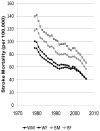Traditional risk factors as the underlying cause of racial disparities in stroke: lessons from the half-full (empty?) glass
- PMID: 21960581
- PMCID: PMC3226886
- DOI: 10.1161/STROKEAHA.111.625277
Traditional risk factors as the underlying cause of racial disparities in stroke: lessons from the half-full (empty?) glass
Abstract
Background and purpose: Black/white disparities in stroke incidence are well documented, but few studies have assessed the contributions to the disparity. Here we assess the contribution of "traditional" risk factors.
Methods: A total of 25 714 black and white men and women, aged≥45 years and stroke-free at baseline, were followed for an average of 4.4 years to detect stroke. Mediation analysis using proportional hazards analysis assessed the contribution of traditional risk factors to racial disparities.
Results: At age 45 years, incident stroke risk was 2.90 (95% CI: 1.72-4.89) times more likely in blacks than in whites and 1.66 (95% CI: 1.34-2.07) times at age 65 years. Adjustment for risk factors attenuated these excesses by 40% and 45%, respectively, resulting in relative risks of 2.14 (95% CI: 1.25-3.67) and 1.35 (95% CI: 1.08-1.71). Approximately one half of this mediation is attributable to systolic blood pressure. Further adjustment for socioeconomic factors resulted in total mediation of 47% and 53% to relative risks of 2.01 (95% CI: 1.16-3.47) and 1.30 (1.03-1.65), respectively.
Conclusions: Between ages 45 to 65 years, approximately half of the racial disparity in stroke risk is attributable to traditional risk factors (primarily systolic blood pressure) and socioeconomic factors, suggesting a critical need to understand the disparity in the development of these traditional risk factors. Because half of the excess stroke risk in blacks is not attributable to traditional risk factors and socioeconomic factors, differential impact of risk factors, residual confounding, or nontraditional risk factors may also play a role.
Figures



References
-
- Centers for Disease Control and Prevention (CDC) CDC WONDER. Available at http://wonder.cdc.gov/. Retrieved July, 2010.
-
- CDC. Ten Great Public Health Achievements -- United States, 1900–1999. MMWR. 1999;48:241–243. - PubMed
-
- U.S. Department of Health and Human Services. Healthy People 2010: Understanding and Improving Health. 2. Washington, DC: U.S. Government Printing Office; Nov, 2000.
-
- Howard G, Howard VJ. Ethnic disparities in stroke: the scope of the problem. Ethn Dis. 2001;11:761–768. - PubMed
-
- Wolf PA, D’Agostino RB, Belanger AJ, Kannel WB. Probability of stroke: a risk profile from the Framingham Study. Stroke. 1991;22:312–318. - PubMed
Publication types
MeSH terms
Grants and funding
LinkOut - more resources
Full Text Sources
Medical

